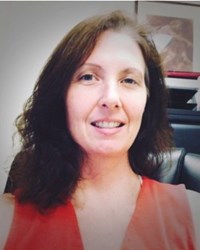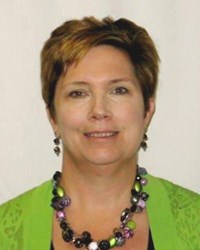VCU Health: Hospital Capacity Management, Care Progression and Collaboration
Kelley Barry, Clinical Applications Analyst–Senior, VCU Health and Lynn Goodloe, MS, CNRN, NE-BC, Director of Patient Flow, VCU Medical Center share their story and the amazing work they’re doing to increase capacity by through a combination of technology, people and process. In fact, their work was recognized by HIMSS with the prestigious Davies Award of Excellence, which celebrates the outstanding achievements of organizations that are using health information technology to substantially improve patient outcomes and manage hospital capacity.

What you’ll learn in today’s episode:
-
Charged by senior leadership with improving patient flow and focusing on hospital capacity management, a team of professionals from across the organization—who worked closest with the patients—were brought together as subject matter experts. They examined the literature on operational efficiency, looked at VCU’s processes and then decided what would great look like.
-
The team then gathered the end users of the technology and asked them what could be done to make their jobs easier. How could they get more time back in their days to spend with patients instead of answering calls and questions about throughput and capacity? There were also focused on reducing paper processes and interruptions from phone calls.
-
The highly collaborative relationship between the people on the front lines and the people managing the technology piece resulted in a high-reliability situation. In addition, the effective use of care progression indicators resulted in improved communication across departments.
-
With the new improved communication, the Associate Chief Medical Officer led the charge for coming up with an anticipated day of discharge and a common goal for all care teams to work towards. That changed a lot of things and led to an improved and streamlined discharge process.
-
The successful adoption of technology, an engaged workforce, and hospital capacity management with streamlined processes resulted in a 20% reduction in lost bed time and $23.6 million in new revenue and institutional savings.
Listen Time - 13:05 minutes
KEY TIMESTAMPS
| SME Subject Matter Expert Group | 1:10 |
| Care Progression Indicators | 5:21 |
| Automating Discharge Planning Process | 6:58 |
| How to Sustain Patient Flow Success | 9:45 |
More about this episode
About the Experts
 Kelley Barry
Kelley Barry
Clinical Applications Analyst –Senior, VCU Health
Kelley has been with VCU Health since 2010. She has a BA from VCU and is working on her Information Technology Master’s Degree with Informatics Specialization from the University of Maryland University College.

 Lynn Goodloe, MS, CNRN, NE-BC
Lynn Goodloe, MS, CNRN, NE-BC
Director of Patient Flow, VCU Medical Center
With over 30 years of nursing and leadership experience, Lynn is responsible for the One Call Center and organizational patient placement and flow from all access points. Lynn obtained her bachelor and Master of Nursing degree from the Virginia Commonwealth University School of Nursing, completed a post master’s certification in nursing education, and has achieved her ANCC Nurse Executive Certification.
View Transcript
Welcome to the Patient Flow Podcast powered by TeleTracking. On today’s episode, TeleTracking’s Susan McLaughlin chats with patient flow specialists from Virginia Commonwealth University Health. Kelley Barry is Senior Clinical Application’s Analyst and Lynn Goodloe is the Director of Patient Flow. VCU Health has been doing ground breaking work with care progression indicators and was recently awarded the HIMSS Davies Award of Excellence for outstanding achievements of organizations that have utilized health information technology to improve patient outcomes and value.
Susan: How did you determine the processes at VCU that needed to be fixed and the role that communications played in achieving that goal?
Lynn: Our senior leadership set a goal for us. That was a bigger goal than we had ever been able to achieve before, in terms of patient flow and increasing capacity. And so what we knew is, the physician and I that were charged with helping the organization lead this goal, knew that we didn't know all the answers.
And so the first thing that we did was really to look around the organization at inter-professional leaders that were closest to the patients and bring them together. We called them a SME group, so a subject matter expert group. And we got together and spent about 16 hours in a room, two 8-hour days where we really examined the literature and then looked at what our processes were and then decided what would great look like.
And so from my perspective, even without looking at the textbook, we did it right because we started with people and then moved to processes and the last thing we did was leverage technology. When I look back at it, even though I'm not sure we knew that's exactly what we were doing, that's what we did. And those people, the original subject matter expert group, lead us to putting forth recommendations around things we could do better. Then we rallied medical, and nursing, and other inter-professional colleagues, that touch all of our inpatient and even ambulatory areas, to help us move forward and really provide better care to our patients and our community.
Susan: How did you engage your teams members and get them to adopt this new way of doing things?
Kelly: When it came down to the functionality and engaging our team members, we gathered a group of subject matter experts who would actually be using the tool. And we knew we had to make the tool function in a couple of ways, and one was to make it meaningful to teams.
And the only way to do that was to gather a group of subject matter experts together in a room who were the end users of the technology and ask them how can we make your job easier? How can we give you more time back in your day to spend with the patient instead of answering calls and answering questions about throughput and capacity. We knew we had to make it meaningful and they were very vocal. They knew exactly what they wanted and knew exactly what they didn't want.
We wanted to reduce paper processes for the team too. They were tired of shuffling around papers and trying to find information. And not communicating in one space where everyone can get the same information at the same time. We wanted to reduce phone call interruptions which was another problem that they were having. If they had question about where a patient was in their discharge process, we didn't want a phone call to be the only way to get that information. So, we had to reduce their phone call interruptions.
We needed to focus on safety, safety is very important to every organization and especially at VCU Health. We wanted to increase transparency, and we did all of this by layering the communication that they thought was lacking and communicating their discharge process and their patient discharge readiness. So we really listened to our end users and asked them how can we make this meaningful for you and they gave us all the feedback we needed to get started. They had needed something for so long that they came with amazing ideas. And we're still not done with the work that started in that particular project.
Lynn: I'm really glad you said that Kelly 'cause as I was thinking about what you were saying, to this day the teams are telling us what they need and so Kelly's work and the work of our IT department is only beginning in terms of leveraging the technology and what it's really done is help create a highly reliable situation. Because while we wanted to increase capacity, what we really wanted to do is provide better care to our patients. And the by-product of that has been increase in capacity. Wouldn't you say Kelly?
Kelly: Absolutely! It's exciting for our work to not be done yet and to have kind of a cue of jobs waiting for us to get to next. It really is exciting.
Susan: You've had success in the past using care progression indicators. Can you talk about the role that those have played in improving communications? For example, I know you've created care progression indicators for departments like pharmacy, and there's also one for occupational & physical therapy. Can you talk about how that really helps improves communication between the different units and therefore create a better patient experience?
Kelly: Absolutely. Well that was the end result of our meeting with our end users. It was clear that we had the functionality already throughout the organization and we had rolled it out several times before but didn't have the buy-in because we really weren't in a position to gather all of those folks together in one room. Once we did, we just fine tuned technology that we already had, and we realized by eliminating services like, PT and OT, it was very obvious that we were missing other services as well, like discharge pharmacy.
Units were used to seeing information about PT and OT and they were like we need discharge pharmacy. They were the ones that gave us that information, they brought it back to us, and discharge pharmacy was willing to join in on the communication tools and it worked out really well.
Susan: Talk a little bit more about your discharge planning process and the tactics that you used to improve that. I know you used an anticipated day of discharge as part of that and how did automating the pending discharges help, especially with Medicare compliance?
Kelly: Absolutely, we had all of these great teams communicating their information and they what we found is that we didn't have a common goal for all of these great teams to work towards. And so Lynn and our Associate Chief Medical Officer, Dr. Heather Masters, led this charge for coming up with an anticipated day of discharge and a common goal for all of these care teams to work towards. And that really changed a lot of things for us and helped improve and streamline our discharge process, because everyone was working toward the common goal and communicating any barrier along the way. So we as a team could help eliminate those barriers.
We struggled with our pending discharge compliance because it was a manual process. Some units were great, some weren't. But what happened was, our leaders instituted this anticipated date of discharge and transformed our transitional care rounds that we have every day on the unit that would focus on the transition of the patient. They're 15 minutes, some organizations call them flash rounds, there's so many iterations of these rounds. So what happens in every round, is that the care coordinator always asks, when do you anticipate the patient to be discharged?
And then they update that information in tele-tracking. What they do is the providers has given us feedback, that is a provider satisfaction, because they are communicating to the whole environment through their flash rounds. So there are less questions about the anticipated day of discharge. We have increased patient satisfaction because then that information from TeleTracking should be put on their patient communication board in the room. So you're drawing in the patient and their family to and including them on those decisions and that information that's being discussed in the transitional care rounds.
And then we use the automated pending discharge to leverage that anticipated day of discharge to automatically flip to pending discharge the day of discharge. So, then that communicates to patient flow where are we with our capacity for that day. And we saw a 30% increase in discharge compliance after we flipped that switch and really had a solid anticipated day of discharge process.
Susan: Your results have been amazingly impressive. You've experienced a 20% reduction in lost bed time and 23.6 million in new revenue and institutional savings. How are you going to sustain that and what plans are on the horizon?
Lynn: That's a great question and I think it is a question that the entire leadership team that is coming together as a throughput and capacity work stream ask itself every time that we meet. I think the thing that continue to drive us is the caregivers, really those who are closest to the patient, I think Kelly alluded to this earlier, are continuing to tell us what they need in order to continue this work. So, I think the most important thing we can do is continue to listen to them and as they're able to tell us what they need in terms of communication. Then let us figure out how we can leverage the tools. I think that is going to continue to be our secret to success.
I know you talked about some of the metrics but, the entire patient care team has celebrated what has almost been almost a 20% decrease in diversion hours as we've done this work. A 13% decrease in calls to our patient flow coordinators because they've been able to leverage the tool that we have. So neither the direct care providers or our patient flow coordinators are having to spend time on the phone, potentially calling when someone's in the middle of patient care or other type of work processes. We've also been able to accept more hospital to hospital transfers. I think the fact we are able to give them success metrics back and then they're able to, each month, tell us what's working and what's not working.
Kelly and I was just in a meeting last week with care givers across the organization that were telling us how we can continue to leverage the pharmacy indicator, to prioritize which meds to fill first based on when the patient is going home. So we're not filling the patients meds that might be going home at 4 o'clock this evening before the patient that needs to go home at 11. I really think that is what our secret to success is, but Kelly you may have other thoughts.
Kelly: Lynn, I totally agree with all you said. I just want to say that Lynn and our Associate Chief Medical Officer, Dr. Masters, continue to support each and every unit with their transitional care rounds, and give them feedback both positive and constructive, for them to continue to excel in that communication, and they're doing an amazing job. They're using transparency to show them what their scores are so they can see those units who are functioning at a much higher level or someone struggling, so they can then collaborate. So, it opens up the door for continued collaboration. Not only between services, but between units to see how is someone better or getting little higher scores and things like that.
But the fact that they're still continuing to support these units and certainly transitioning the support down as the time goes along. But the fact that we're not just saying you're done, we're gone, we're going to move on to the next one; they're continuing to support these teams and the great work that they're doing.
This is the Patient Flow Podcast powered by TeleTracking. Your source for insightful conversations by industry leaders making a difference in patient flow today.
More information about this resource
We're glad you're enjoying our resources! Please tell us more about you to access our full library.
This will allow us to personalize your experience on TeleTracking.com. Of course, we will never sell your information and you can opt-out at any time. Need help now? Contact a Patient Flow expert.
Leaving the website
You're about to leave this website, to one of our affiliates or another information source.